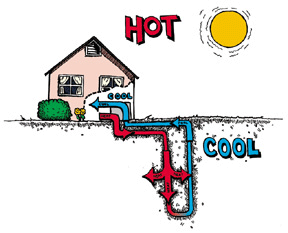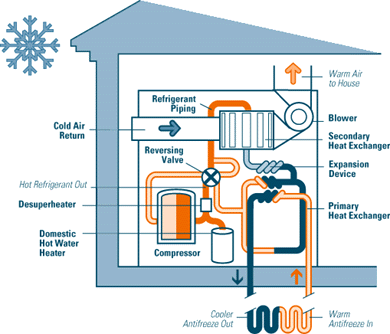GROUND-SOURCE-HEAT-PUMPS
Mother Earth Will Wrap You In Warmth

Ground-Source Heat Pumps
If you are interested in installing an environmentally responsible heating, air conditioning and water heating system in your home, you have come to the right page.
Ground source heat pump systems are still rare mostly due to cost, but seem to be on the upswing each year due to increasing utility bills.
The
Environmental Protection Agency
(EPA) and the
Department of Energy
(DOE) have both listed the ground source heat pump systems as amongst the highest energy efficient and environmentally responsible home comfort and water heating systems available today.
The EPA has stated that geothermal technologies represent a major opportunity for reducing national energy use and pollution, while delivering comfort, reliability, and savings to the homeowner.
The greatest heat storage facility available on Earth is the Earth itself. Temperatures below the surface of our planet remain virtually constant, whether it be winter, summer, spring, or fall. Ground source heat pumps tap into this stored energy to provide hot water, cooling and heating for homes.
Residential applications are the subject here, but are certainly not the only viable options for use of a ground source heat pump system. Commercial or industrial structures can benefit from these types of systems, as well.
Closed Loop GSHP System
A closed loop system can be installed horizontally under a lawn or garden area, driveway, or even under the home itself, anywhere that the required piping can be installed. The piping can also be installed vertically in shafts drilled for the piping. Your geothermal specialist will determine, after inspecting your site, which approach suits your application best. Factors he will be looking for are soil conditions, available space, installation economy, and the type of rock in the area.
 Closed loop systems utilize water or an antifreeze solution circulating through plastic or copper piping installed beneath the earth's surface. During the heating season, the fluid is pumped through the loops, collecting heat from the ground and delivers the heat into the heat pump inside the building. During the summer, for cooling, the process is reversed. Heat is pulled from the residence and pumped out through the system loops to store the heat in the ground. Cool fluid returns to cool the residence.
Closed loop systems utilize water or an antifreeze solution circulating through plastic or copper piping installed beneath the earth's surface. During the heating season, the fluid is pumped through the loops, collecting heat from the ground and delivers the heat into the heat pump inside the building. During the summer, for cooling, the process is reversed. Heat is pulled from the residence and pumped out through the system loops to store the heat in the ground. Cool fluid returns to cool the residence.
Inside, the heat pump is a package unit, which has a refrigerant loop, a water loop, a compressor, a reversing valve, and a heat exchanger. The transfer of heat actually takes place at the heat exchanger, which transfers the heat from the water into the refrigerant, or vice-versa, depending upon heating or cooling cycle.
In heating cycle, the water from outside passes past a refrigerant filled heat exchanger. Heat transfers into the refigerant and boils to become a vapor. The vapor is then compressed causing it to become even hotter. Then the hot gas passes through the coil, where air is forced through the coil, picking up the heat and distributing it to the living space.
Once again, this process is reversed for cooling.
Not to confuse the issue, but some systems actually use the refrigerant to make a direct heat transfer outside with the ground. The process inside the heat pump is very similar to a split system air conditioner's process.
This process can also provide free hot water during the summer months, by passing the hot water collected during cooling mode through a water-to-water heat exchanger. A heat transfer takes place and the potable hot water is stored in a tank for use. This same process can deliver substantial hot water savings during the winter also.
A ground source heat pump system can be fitted to any residential project, new construction or retrofit, single-family or multi-family. For a retro-fit application, the existing ductwork from your former furnace or air handler can usually be used as the distribution system with minimal alterations.
Many geothermal companies work closely with a conventional heating and air conditioning company for the ability to provide the full package.
Open Loop Water Source Heat Pump Systems
Some residences have access to a pond or lake on their property. This is another good source for heat transfer from the piping system. An open loop water system can provide similar benefits of the closed loop system.

The operation is identical other than the loop piping system is placed directly on the bottom of the pond. The system pumps pull in water for the heating and cooling of the residence and then discharge the water directly back into the pond, into a return well, or into a leech field.
Installation of this type of system may require the approval of your local authorities. Due to the fact that open dispersal of the water back into the environment will mix with ground water, the authorities may wish to verify it’s source and cleanliness. It’s easier to get approved beforehand, than to back-pedal for approvals.
Installation of geothermal, a ground source heat pump, or a water source heat pump is certainly not the most economical route to go for heating and cooling your home, on initial installation. But, the benefits abound. Manufacturers are offering rebates and special financing. Many utility companies offer rebates to help with installation. Both the homeowner and the builder should check into these programs when considering this type of system.
Benefits of a Ground Source Heat Pump
- Up to 50% savings on energy used to heat hot water
- Can both heat and cool your home, and provide all of your hot water needs
- Equipment size is very similar to the traditional forced air heating and air conditioning system
- Energy consumption can be cut by 20-50%
- Maintenance costs may be reduced
- Underground piping carries a 50 year warranty
- Systems are very quiet, both inside and out. No noisy compressors outside
- No dangerous and unsightly outside fuel storage tanks
- Air inside the home is distributed more evenly. Hot and cold spots are gone
A ground source heat pump does provide savings:
- Save money in operating and maintenance costs
- Over time, the energy savings will exceed the installation costs. Make money on the deal! For the right system, your investment dollar may be recouped in only a few years
- Rebates are available in most areas from local utility companies. Federal tax credits may also be available to help offset the initial installation costs
- Heating efficiencies as much as 70% higher than conventional. Cooling efficiencies as much as 40% higher than conventional systems
If that isn’t enough to convince you to consider this type of system, think about our environment.
- No external venting into our atmosphere of harmful waste byproducts
- Ground source heat pump systems which do use refrigerants are factory sealed, and seldom need recharging. Possibility of freon release to the atmosphere and damaging our ozone layer almost non-existent
- Conservation of our natural resources
- No burning of fossil fuels
Return to Geothermal Main Page
Return to Heat Pump Main Page
Leave Ground Source Heat Pump and Return to HOME

Please feel free to link to this page from your website. This page's URL is: http://www.perfect-home-hvac-design.com/ground-source-heat-pump.html
Enjoy this page? Please pay it forward. Here's how...
Would you prefer to share this page with others by linking to it?
- Click on the HTML link code below.
- Copy and paste it, adding a note of your own, into your blog, a Web page, forums, a blog comment,
your Facebook account, or anywhere that someone would find this page valuable.